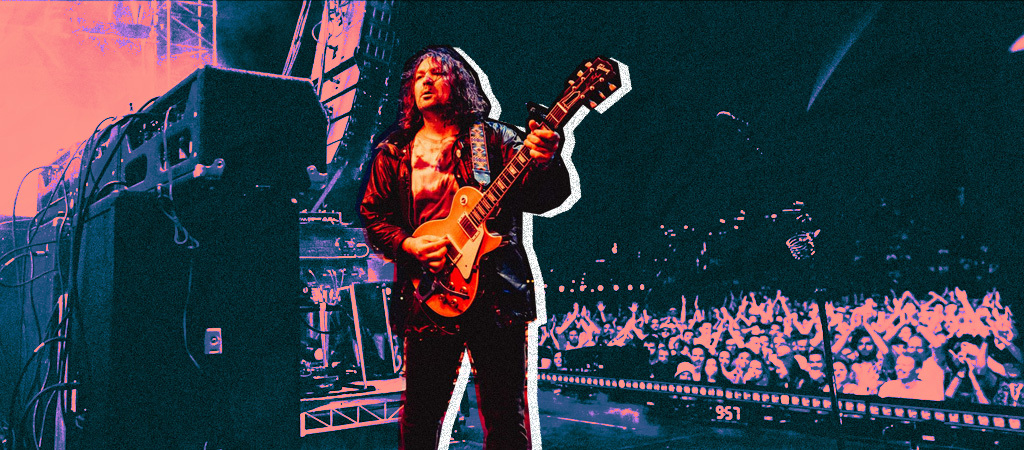This week, The National and The War On Drugs commence a 19-date nationwide run of shows. It has been dubbed The Zen Diagram Tour, and I can only assume that the title refers to the commonly held belief that the same sort of person loves both The National and The War On Drugs. In this instance, that person happens to be me. Sure enough, I will be attending this tour in two weeks. I will be the flannel-shirted man with the salt and pepper beard. You won’t be able to miss me.
Incredibly, this is the first time these groups have toured together. But it is not the first time they have appeared on the same bill. That happened back in 2011 at the Beacon Theater in Manhattan and — would you believe it? — I was at that show as well. It was a fun night. I remember that we were all younger. I was much younger. A fresh-faced 34-year-old, the proverbial babe in the woods!
A few weeks before that gig, I moderated an interview between The National’s Aaron Dessner and The War On Drugs’ Adam Granduciel and Dave Hartley that (I think) was the first substantive conversation between the musicians. I revisited the article this week for the first time in many years, and it was a fascinating time capsule. At the time, The National had ascended to “large theater headliner” status in the wake of 2010’s High Violet. And The War On Drugs made their first significant impression outside of their home base of Philadelphia with the release of their second full-length, Slave Ambient. One of the record’s biggest boosters was Dessner, who had requested a public audience with Granduciel and Hartley after listening obsessively to Slave Ambient for months. He was especially taken with what he termed TWOD’s “organic” experimentation, which he contrasted with his own band’s tendency to constantly tinker until the last possible moment before putting out music.
My favorite part of the interview happens near the end, when Dessner suggests — kind of “jokingly,” he says — that The War On Drugs could one day fill arenas. “I would be so happy if music as good as this could do that someday, because it has that kind of wide horizon to it. It doesn’t feel like it would be a struggle for it to communicate on that kind of level.”
What Dessner possibly didn’t know is that The War On Drugs had only recently come into their own as a live act. The fourpiece that toured in support of Slave Ambient formed the first steady core of the band, with Granduciel supported by fellow charter member Hartley and keyboardist/guitarist Robbie Bennett. (A few years later, for the Lost In The Dream tour, the “classic” lineup solidified with the additions of drummer Charlie Hall, guitarist Anthony LaMarca, and multi-instrumentalist Jon Natchez.) In the studio, Granduciel made a lot of Slave Ambient by himself, writing songs as he was recording them by meticulously assembling countless instrumental passages, samples, and overdubs. To Dessner, he admitted that “before the record came out, I wasn’t sure how we were going to play them.”
Dessner then pivoted to reminiscing about the upsides of being a tour opener. “I kind of love opening, because it’s easier and kind of just more fun to get up and play fast and furious and have a good time.”
Adam concurred. “You have, like, two hours afterwards to party and hang out.”
If only they knew that the “party and hang out” days were already behind them.
I thought about that bygone interview from the first Obama administration while listening to Live Drugs Again, the second concert album in four years from The War On Drugs, out Friday. It follows 2020’s Live Drugs, a stirring capstone for the Lost In The Dream and A Deeper Understanding eras that leaned into the grandest — what Dessner termed the “wide horizon” — aspects of their music. It was regal and imposing and smooth, like a monolith, an impression supported by the pitch-black cover. It felt like a record that should have been packaged inside of a deluxe double-CD jewel case and sold at Sam Goody for $18.99.
Like Live Drugs, Live Drugs Again is a Frankenstein version of a live record, with each track composed of stitched-together moments lifted from countless performances. (I suspect only Granduciel knows exactly the myriad sources from which each song derives.) This approach makes sense coming from a man who assembles music like the rest of us contemplate jigsaw puzzles. Though the purist in me objects to this approach, especially given the number of excellent intact War On Drugs bootlegs just waiting for a sonic upgrade. (The three-show “Drugscember To Remember” stand from 2022 immediately comes to mind.) While these shows aren’t as technically perfect as the growing Live Drugs franchise, they have a sense of narrative and vibe that the official concert releases can’t match.
Of course, when I put on Live Drugs Again, the purist in me is eventually drowned out. This is epic rock ‘n’ roll that manages to top even the titanic Live Drugs, if only because The War On Drugs are that much better as a live band. Yes, I could quibble with some of the song choices. (I, for one, would have replaced “Pain” — a repeat from Live Drugs — with the rousing cover of Bob Seger’s “Against The Wind” that highlighted many shows on this tour.) But how can I complain when this band clearly “let the cowboys ride” on their own songs in ways that often top their recorded takes?
Several tracks already feel like definitive versions. “Harmonia’s Dream” was a consistent highlight of the I Don’t Live Here Anymore tour, and Live Drugs Again honors that with an extended open in which a trance-inducing electronic pulse is augmented by infectious arena-rock audience clapping. The build in “Old Skin” to Hall’s dramatic entrance packs a wallop on the album, but live it has that extra E Street-esque oomph that really elevates the song. And then there’s “I Don’t Live Here Anymore,” which feels more and more like The War On Drugs’ finest anthem. On Live Drugs Again, we hear Granduciel honor his band in the intro, giving hype-man intros for each member and drawing out the last syllable in every name like he’s Paul Stanley addressing the unwashed hoards at Cobo Hall.
This sort of showmanship from the once-reticent leader of The War On Drugs is the most obvious departure point from the original Live Drugs. At some point during the I Don’t Live Here Anymore era, Granduciel embraced his inner rock star, drawing on the impassioned evangelism of perhaps his two most important influences, Bruce Springsteen and Mike Scott of The Waterboys. On “Burning” and “Under The Pressure,” he pushes his vocals like never before, practically shouting his way to new musical climaxes as his fellow bandmates aspire to maximum levels of heartland rock grandiosity. It’s no longer “Burning,” it’s now “Burninnnnng.” And “Under The Pressure” is gone, meet “Under The Preshhhhahhhhh!” (There’s also the matter of Granduciel’s always stellar guitar playing, which achieves peak shred-itude on the sultry “I Don’t Wanna Wait” and the welcome Slave Ambient deep cut, “Come To The City,” not to mention the obvious six-string showcase that is “Under The Pressure.”)
Putting out multiple live albums in relatively quick succession during an era when most bands wouldn’t think of putting out a single concert record says a lot about how The War On Drugs have evolved since that conversation with Aaron Dessner at the end of 2011. It reasserts the group identity that Granduciel pushed to the fore on the last studio record, as well as the importance of their live show as a calling card on nearly equal footing with their immaculate and deliberative studio work.
It also reiterates The War On Drugs’ relationship with hugeness. It differs from The National’s relationship with hugeness, which in recent years has manifested with Dessner’s entrée into the worlds of Taylor Swift and stadium pop. It’s hugeness as a form of celebrity and cultural capital. Granduciel has only fitfully flirted with that sort of hugeness, contributing guitar to records by Beyoncé and Miley Cyrus. Otherwise, his brand of hugeness is musical and spatial. As The War On Drugs’ audience grows, the music continues to expand ever-so-slightly beyond the confines of wherever they’re playing. When I saw them open for The National at the Beacon Theater 13 years ago, they were a small band who filled every square inch of the venue with guitar drones and synth swells. It was a wave of sound intended to overwhelm the senses, which it did.
Live Drugs Again feels like that, too. It’s the widest iteration yet of the “wide horizon” sound. The War On Drugs made the Beacon feel like a phone booth. And every time I’ve seen them since, they have given me the same feeling, whether it was a theater, an arena, or an open field. I look forward to seeing them push toward the next horizon.







